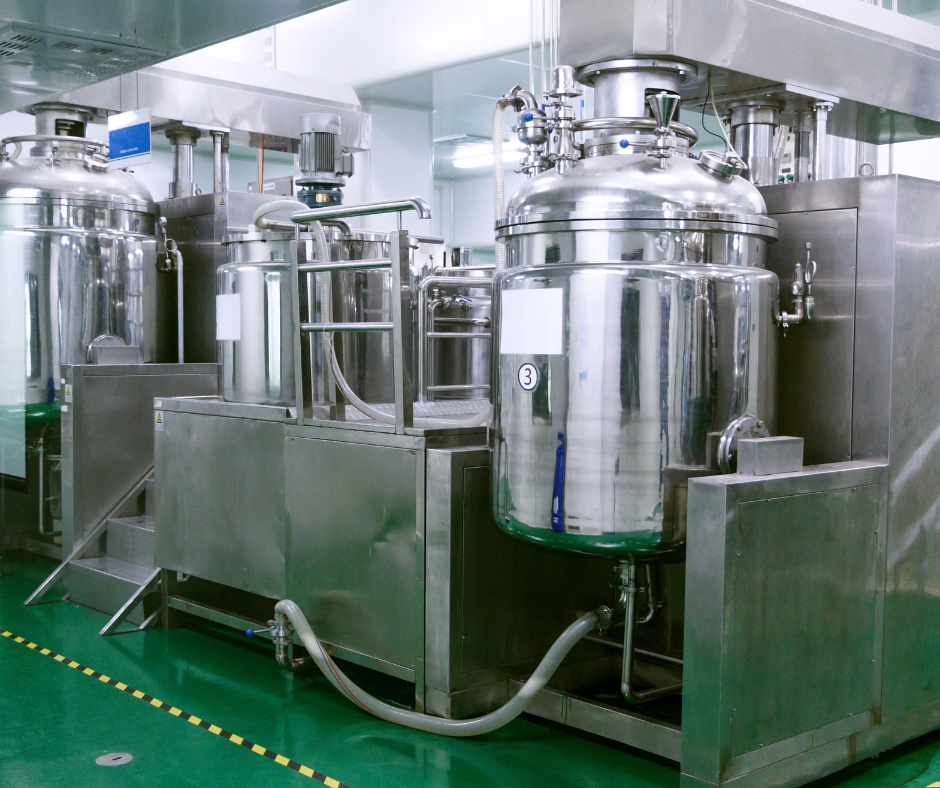Chemical manufacturing is a vital industry that plays a significant role in many aspects of modern life, from producing essential materials for the construction and automotive industries to manufacturing pharmaceuticals and personal care products. However, the production, use, and disposal of chemicals can have significant environmental and health impacts, leading to the development of a complex regulatory landscape governing the chemical manufacturing industry.
In this article, we will examine the impact of chemical manufacturing regulations on the industry and explore how regulations have evolved over time to improve safety, protect the environment, and promote sustainability.
- Overview of Chemical Manufacturing Regulations
- Impact of Chemical Manufacturing Regulations on the Industry
- Evolution of Chemical Manufacturing Regulations
- Challenges Facing the Industry
- How can Deskera Help You?
- Conclusion
Overview of Chemical Manufacturing Regulations
The regulatory framework governing the chemical manufacturing industry is complex and multifaceted, involving a range of federal, state, and international laws, regulations, and guidelines. At the federal level in the United States, the Environmental Protection Agency (EPA), the Occupational Safety and Health Administration (OSHA), and the Food and Drug Administration (FDA) are among the key agencies responsible for regulating chemical manufacturing activities.
The EPA regulates the production, use, and disposal of chemicals to protect human health and the environment. The agency has authority under several major environmental laws, including the Clean Air Act, Clean Water Act, Resource Conservation and Recovery Act, and Toxic Substances Control Act. The EPA also manages the Chemical Data Reporting (CDR) program, which requires manufacturers and importers of certain chemicals to report information on the production, use, and exposure of those chemicals.
On the other hand, OSHA is responsible for ensuring workers' safety and health by setting and enforcing workplace safety standards. The agency has developed specific standards for chemical manufacturing operations, such as the Process Safety Management (PSM) standard, which requires facilities to develop and implement programs to prevent or minimize the consequences of catastrophic releases of hazardous chemicals.
The FDA regulates the manufacture and marketing of pharmaceuticals, medical devices, and food and cosmetic products, which can also involve the use of chemicals. The agency requires manufacturers to adhere to strict guidelines and standards for quality and safety to ensure that products are safe and effective for their intended use.
In addition to federal regulations, many states have their own regulations governing chemical manufacturing activities. For example, California has adopted strict regulations under the California Safe Drinking Water and Toxic Enforcement Act (Proposition 65), which requires businesses to provide warnings to consumers if their products contain chemicals known to cause cancer or reproductive harm.
Internationally, the United Nations has developed the Globally Harmonized System of Classification and Labelling of Chemicals (GHS), which provides a standardized approach to classifying and labeling chemicals based on their physical, health, and environmental hazards. The GHS has been adopted by many countries, including the United States, as a means of improving the consistency and clarity of chemical hazard communication.
Impact of Chemical Manufacturing Regulations on the Industry
Chemical manufacturing regulations have had a significant impact on the industry, influencing everything from product development and production processes to worker safety, environmental impact, and business operations.
Product Development and Production Processes
Chemical manufacturing regulations have had a profound impact on product development and production processes, requiring manufacturers to prioritize safety, environmental impact, and sustainability in their operations. Regulations have driven the development of safer, less toxic, and more sustainable chemical products, as well as more efficient and environmentally friendly production processes.
For example, the EPA's Safer Choice Program encourages the development of safer chemical products by providing certification to products that meet strict safety and environmental criteria. This program has led to developing many safer and more sustainable alternatives to traditional chemical products, from cleaning products to industrial solvents.
Similarly, adopting process safety management (PSM) standards has led to improvements in production processes by requiring facilities to implement rigorous safety management systems to prevent catastrophic releases of hazardous chemicals. These standards have helped to reduce the number of accidents and incidents in the industry, protecting workers and the surrounding communities.
Worker Safety
Regulations governing the chemical manufacturing industry have significantly impacted worker safety, requiring manufacturers to prioritize the health and safety of their employees. The OSHA PSM standard, for example, requires facilities to implement programs to prevent or minimize the consequences of catastrophic releases of hazardous chemicals, which can pose a significant risk to workers.
OSHA has also developed specific standards for chemical manufacturing operations, such as the Hazard Communication Standard, which requires employers to provide information and training on the hazards of chemicals in the workplace. This standard has helped to improve awareness and understanding of the risks associated with chemical exposure, leading to improved safety measures and practices in the industry.
Environmental Impact
The production, use, and disposal of chemicals can have significant environmental impacts, from air and water pollution to soil contamination and ecosystem disruption. Chemical manufacturing regulations have been developed to address these impacts, requiring manufacturers to take steps to minimize their environmental footprint and protect natural resources.
The EPA's regulations under the Resource Conservation and Recovery Act, for example, require manufacturers to properly manage and dispose of hazardous waste generated during chemical manufacturing processes. These regulations have led to improved waste management practices, reducing the risk of environmental contamination and protecting public health.
The Clean Air Act and Clean Water Act also regulate emissions and discharges from chemical manufacturing facilities, requiring facilities to monitor and report their emissions and take steps to reduce their environmental impact. These regulations have significantly improved air and water quality around chemical manufacturing facilities.
Business Operations
The regulatory landscape governing the chemical manufacturing industry has also significantly impacted business operations, requiring manufacturers to allocate resources to comply with regulations and adapt to changing regulatory requirements.
Compliance with regulatory requirements can be time-consuming and expensive, requiring manufacturers to invest in new technologies, systems, and processes to ensure they are meeting regulatory standards. However, failure to comply with regulations can also be costly, resulting in fines, legal action, and reputational damage.
The complexity of the regulatory landscape can also pose challenges for businesses, particularly smaller businesses that may need more resources to navigate the complex regulatory environment. In addition, regulatory requirements can vary by jurisdiction, requiring manufacturers to stay updated on changing regulations and comply with multiple sets of requirements.
Evolution of Chemical Manufacturing Regulations
The regulatory landscape governing the chemical manufacturing industry has evolved significantly over time, reflecting a growing awareness of chemical production and use's environmental and health impacts.
In the early 20th century, few regulations existed to govern chemical manufacturing activities, and many of the chemicals produced at that time were highly toxic and had significant environmental impacts. The environmental movement of the 1960s and 1970s led to the development of a series of environmental regulations, including the Clean Air Act, Clean Water Act, and Resource Conservation and Recovery Act, which established the foundation of the regulatory landscape governing the industry today.
In the 1980s, concerns about the health impacts of chemicals led to the development of the Toxic Substances Control Act (TSCA), which gave the EPA authority to regulate the production, use, and disposal of chemicals. However, the TSCA has been criticized for its limited authority and lack of transparency, leading to calls for reform.
In 2016, the Frank R. Lautenberg Chemical Safety for the 21st Century Act was passed, amending the TSCA and giving the EPA expanded authority to regulate chemicals. The new law requires manufacturers to provide more information on chemicals' safety and potential health impacts. It gives the EPA the authority to ban or restrict chemicals that pose significant health or environmental risks.
International regulations have also evolved, reflecting a growing recognition of the need for a coordinated global approach to chemical safety. The United Nations developed the Globally Harmonized System of Classification and Labeling of Chemicals (GHS) in 2003, which standardized the classification and labeling of chemicals and has been adopted by countries around the world. In addition, the Stockholm Convention on Persistent Organic Pollutants, the Rotterdam Convention on the Prior Informed Consent Procedure for Certain Hazardous Chemicals and Pesticides in International Trade, and the Basel Convention on the Control of Transboundary Movements of Hazardous Wastes and Their Disposal have established international frameworks for the management and control of hazardous chemicals and waste.
Challenges Facing the Industry
While chemical manufacturing regulations have had significant benefits for the industry and the public, they also pose a number of challenges for manufacturers.
Compliance Costs
Compliance with regulatory requirements can be expensive, particularly for smaller businesses that may not have the resources to invest in new technologies or hire additional staff to meet regulatory requirements. The costs associated with compliance can also be unpredictable, as regulations may change over time or vary by jurisdiction.
Regulatory Complexity
The regulatory landscape governing the chemical manufacturing industry is complex and can be difficult to navigate, particularly for smaller businesses that may not have the resources to keep up with changing regulations or comply with multiple sets of requirements. In addition, regulations can vary by jurisdiction, adding to the complexity and cost of compliance.
Competitive Disadvantages
Regulatory requirements can put manufacturers at a competitive disadvantage, particularly if they operate in jurisdictions with more stringent regulations than their competitors. This can create an uneven playing field for businesses and may discourage investment in certain regions.
Need for Innovation
Developing new chemicals and products requires significant research and development, which can be costly and time-consuming. In addition, regulatory requirements may make it more difficult for manufacturers to introduce new products to the market, particularly if they are subject to stringent safety and environmental regulations.
Public Perception
The chemical manufacturing industry has long been associated with negative environmental and health impacts, which can lead to public distrust and opposition to the industry. Regulatory requirements can help to mitigate these impacts, but more is needed to overcome negative public perceptions.
How can Deskera Help You?
Deskera's integrated financial planning tools allow investors to better plan their investments and track their progress. It can help investors make decisions faster and more accurately.
Deskera Books can assist you in automating your accounting and mitigating business risks. Deskera makes it easier to create invoices by automating many other procedures, reducing your team's administrative workload.
Deskera also offers a suite of integrated applications to help businesses manage their financials, inventory, and operations. Furthermore, other business aspects such as HR (Deskera People), CRM (Deskera CRM), and ERP are provided by Deskera. These could be crucial and can help short sellers keep track of their businesses and make better decisions.
Conclusion
Chemical manufacturing regulations have significantly impacted the industry, helping to protect public health and the environment, improving worker safety, and setting standards for the responsible production and use of chemicals. However, regulatory requirements can also pose challenges for manufacturers, particularly smaller businesses that may need more resources to comply with complex and evolving regulations.
To address these challenges, manufacturers must invest in compliance measures and work to develop new products and processes that meet regulatory standards. In addition, collaboration with regulatory agencies, industry organizations, and other stakeholders can help foster a more transparent and effective regulatory environment that balances the need for safety and environmental protection with innovation and economic growth.
Related Articles










